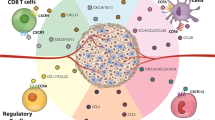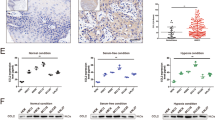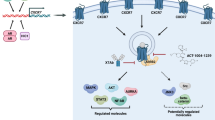Abstract
Chemokine receptor 7 (CCR7) upregulation, which mediates immune cell survival and migration to lymph nodes, has recently been associated with nodal metastasis of squamous cell carcinoma of the head and neck (SCCHN). However, the mechanism of CCR7 in tumor progression, its downstream signaling mediators, and interactions with other pathways contributing to metastasis of SCCHN have not been determined. We hypothesized that inflammatory chemokine-mediated signals could also promote tumor proliferation and mitogenic effects. Functional assays showed that chemotaxis and invasion of metastatic SCCHN cells were dependent on phosphoinositide-3 kinase (PI3K) and its substrate, activated phospholipase Cγ-1. In addition, treatment of CCR7+ metastatic SCCHN cells with CCL19 (MIP-3β) showed rapid activation of the prosurvival, PI3K/Akt pathway. Transactivation of EGFR-mediated and mitogen-activated protein kinase signaling pathways, which can promote migration and survival in parallel, did not appear to contribute to the functional or biochemical effects of CCR7 stimulation. Thus, proinflammatory chemokine signals that mediate activation, trafficking and survival of tumor-infiltrating immune cells in the tumor microenvironment actually appear to induce signals for progression of cancer cells. The CCR7-mediated pathway in metastatic SCCHN cells functions independently of EGFR signal transduction and therefore may represent an additional target for therapeutic intervention to prevent tumor progression and metastasis.
This is a preview of subscription content, access via your institution
Access options
Subscribe to this journal
Receive 50 print issues and online access
$259.00 per year
only $5.18 per issue
Buy this article
- Purchase on Springer Link
- Instant access to full article PDF
Prices may be subject to local taxes which are calculated during checkout





Similar content being viewed by others
References
Amornphimoltham P, Sriuranpong V, Patel V, Benavides F, Conti CJ, Sauk J, Sausville EA, Molinolo AA and Gutkind JS . (2004). Clin. Cancer Res., 10, 4029–4037.
Benistant C, Chapuis H and Roche S . (2000). Oncogene, 19, 5083–5090.
Beraud C, Henzel WJ and Baeuerle PA . (1999). Proc. Natl. Acad. Sci. USA, 96, 429–434.
Biswas SK and Sodhi A . (2002). J. Interferon Cytokine Res., 22, 527–538.
Curnock AP, Logan MK and Ward SG . (2002). Immunology, 105, 125–136.
Curnock AP and Ward SG . (2003). J. Immunol. Methods, 273, 29–41.
Datta SR, Brunet A and Greenberg ME . (1999). Genes Dev., 13, 2905–2927.
Ellis CA, Malik AB, Gilchrist A, Hamm H, Sandoval R, Voyno-Yasenetskaya T and Tiruppathi C . (1999). J. Biol. Chem., 274, 13718–13727.
Ganju RK, Brubaker SA, Meyer J, Dutt P, Yang Y, Qin S, Newman W and Groopman JE . (1998). J. Biol. Chem., 273, 23169–23175.
Grandis JR, Chakraborty A, Zeng Q, Melhem MF and Tweardy DJ . (1998). J. Cell. Biochem., 69, 55–62.
Greenlee RT, Hill-Harmon MB, Murray T and Thun M . (2001). CA Cancer J. Clin., 51, 15–36.
Heo DS, Snyderman C, Gollin SM, Pan S, Walker E, Deka R, Barnes EL, Johnson JT, Herberman RB and Whiteside TL . (1989). Cancer Res., 49, 5167–5175.
Kane LP, Andres PG, Howland KC, Abbas AK and Weiss A . (2001). Nat. Immunol., 2, 37–44.
Lango MN, Dyer KF, Lui VW, Gooding WE, Gubish C, Siegfried JM and Grandis JR . (2002). J. Natl. Cancer Inst., 94, 375–383.
Li X, Commane M, Nie H, Hua X, Chatterjee-Kishore M, Wald D, Haag M and Stark GR . (2000). Proc. Natl. Acad. Sci. USA, 97, 10489–10493.
Li YM, Pan Y, Wei Y, Cheng X, Zhou BP, Tan M, Zhou X, Xia W, Hortobagyi GN, Yu D and Hung MC . (2004). Cancer Cell., 6, 459–469.
Lui VW, Thomas SM, Zhang Q, Wentzel AL, Siegfried JM, Li JY and Grandis JR . (2003). Oncogene, 22, 6183–6193.
Luo J, Manning BD and Cantley LC . (2003). Cancer Cell, 4, 257–262.
Mailliard RB, Wankowicz-Kalinska A, Cai Q, Wesa A, Hilkens CM, Kapsenberg ML, Kirkwood JM, Storkus WJ and Kalinski P . (2004). Cancer Res., 64, 5934–5937.
Mills GB, Lu Y, Fang X, Wang H, Eder A, Mao M, Swaby R, Cheng KW, Stokoe D, Siminovitch K, Jaffe R and Gray J . (2001). Semin. Oncol., 28, 125–141.
Murakami T, Cardones AR, Finkelstein SE, Restifo NP, Klaunberg BA, Nestle FO, Castillo SS, Dennis PA and Hwang ST . (2003). J. Exp. Med., 198, 1337–1347.
Pilkington KR, Clark-Lewis I and McColl SR . (2004). J. Biol. Chem., 279, 40276–40282.
Sánchez-Sánchez N, Riol-Blanco L, de la Rosa G, Puig-Kröger A, García-Bordas J, Martín D, Longo N, Cuadrado A, Cabañas C, Corbí A, Sánchez-Mateos P and Rodríguez-Fernández J . (2004). Blood, 104, 619–625.
Sotsios Y and Ward SG . (2000). Immunol. Rev., 177, 217–235.
Thomas SM, Coppelli FM, Wells A, Gooding WE, Song J, Kassis J, Drenning SD and Grandis JR . (2003). Cancer Res., 63, 5629–5635.
Tosi L, Rinaldi E, Carinci F, Farina A, Pastore A, Pelucchi S, Cassano L, Evangelisti R, Carinci P and Volinia S . (2005). Head Neck, 27, 130–137.
Uchida D, Begum NM, Almofti A, Nakashiro K, Kawamata H, Tateishi Y, Hamakawa H, Yoshida H and Sato M . (2003). Exp. Cell. Res., 290, 289–302.
Vanhaesebroeck B and Waterfield MD . (1999). Exp. Cell. Res., 253, 239–254.
Wang J, Xi L, Hunt JL, Gooding W, Whiteside TL, Chen Z, Godfrey TE and Ferris RL . (2004). Cancer Res., 64, 1861–1866.
Wang H, Ubl JJ, Stricker R and Reiser G . (2002). Am. J. Physiol. Cell. Physiol., 283, C1351–C1364.
Wells A and Lillien L . (2004). Sci. STKE, 253, 47.
Acknowledgements
This work was funded by the American Head and Neck Society/American Academy of Otolaryngology (to RLF), and by the University of Pittsburgh Cancer Institute and the Eye and Ear Foundation, through the Stout Family Fund for Head and Neck Cancer Research.
Author information
Authors and Affiliations
Corresponding author
Rights and permissions
About this article
Cite this article
Wang, J., Zhang, X., Thomas, S. et al. Chemokine receptor 7 activates phosphoinositide-3 kinase-mediated invasive and prosurvival pathways in head and neck cancer cells independent of EGFR. Oncogene 24, 5897–5904 (2005). https://doi.org/10.1038/sj.onc.1208740
Received:
Revised:
Accepted:
Published:
Issue Date:
DOI: https://doi.org/10.1038/sj.onc.1208740
Keywords
This article is cited by
-
Gene Expression Profiles in Chemokine (C-C Motif) Ligand 21-Overexpressing Pancreatic Cancer Cells
Pathology & Oncology Research (2020)
-
Expression of chemokine receptor CCR7 is a negative prognostic factor for patients with gastric cancer: a meta-analysis
Gastric Cancer (2017)
-
The role of CCL21/CCR7 chemokine axis in breast cancer-induced lymphangiogenesis
Molecular Cancer (2015)
-
Anti-CCR7 therapy exerts a potent anti-tumor activity in a xenograft model of human mantle cell lymphoma
Journal of Hematology & Oncology (2013)
-
Role of dendritic cells in progression and clinical outcome of colon cancer
International Journal of Colorectal Disease (2012)



